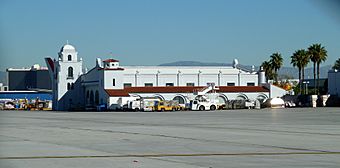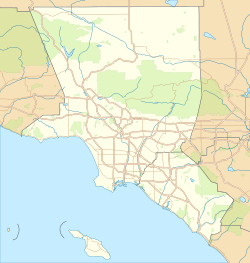Hangar One (Los Angeles, California) facts for kids
|
Hangar One
|
|
 |
|
| Location | 5701 W. Imperial Hwy., Los Angeles, California |
|---|---|
| Area | Los Angeles International Airport (LAX) |
| Built | 1929 |
| Architect | Gable & Wyant |
| Architectural style | Mission/Spanish Revival |
| NRHP reference No. | 92000959 |
Quick facts for kids Significant dates |
|
| Added to NRHP | July 30, 1992 |
Hangar One, also known as Hangar No. 1, is a special airplane building at Los Angeles International Airport (LAX) in Los Angeles, California. It's a very old and important building, so it was added to the National Register of Historic Places in 1992.
Contents
History of Hangar One
Hangar No. 1 was built in 1929. It was the very first building put up at what was then called Mines Field. Back then, the airport was just a dirt landing strip surrounded by fields of beans and barley.
Early Days of the Airport
The city built Hangar One for $35,000. They then rented it to the Curtiss Wright Flying Service. The airport officially opened in 1930 as the Los Angeles Municipal Airport. Later, the city bought it in 1937 and renamed it the Los Angeles Airport.
During these early years, famous people like Charles Lindbergh used the hangar. Even the huge German airship, the LZ 127 Graf Zeppelin, was tied down near its doors when it visited Los Angeles. In 1933 and 1936, thousands of people gathered near Hangar No. 1. They came to watch exciting events like the National Air Races. Regular passenger flights did not start at the airport until December 5, 1946.
Saving a Historic Building
On November 16, 1966, the city of Los Angeles recognized the building's importance. They declared it a Los Angeles Historic-Cultural Monument No. 44. However, the hangar stopped being used in the 1970s and sat empty.
In the early 1980s, there were plans to tear it down. This was to make room for the airport to grow. But a group of people who cared about old buildings and planes stepped in. They convinced airport officials to save the hangar.
Modern Renovation and Use
In 1990, Hangar One got a big makeover that cost $2 million. This renovation made it safe for earthquakes and brought back its original look from the 1930s. As part of this deal, a company called AVIA Development Group was allowed to build two new cargo buildings nearby.
Today, Hangar One is used as a cargo building. It helps with moving goods for the Aviation Facilities Company.
Unique Architecture of Hangar One
Hangar One is a two-story building made of brick and concrete. It was one of five buildings designed in the Spanish Colonial Revival style. This style often features fancy towers, tile roofs, and arches. Hangar One is the only one of those five buildings that is still standing.
The people who designed the hangar likely wanted to make the new airport look impressive. The building is known for its beautiful architecture. It has special towers, pretty tile roofs, and grand arches.





